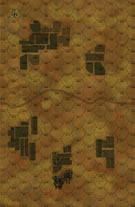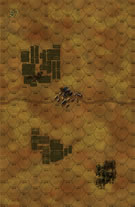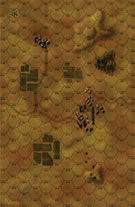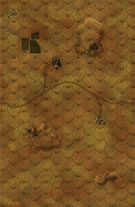|
Kursk - South Flank Scenario 6: Swept Aside Variant Panthers #2 |
||
|---|---|---|
| (Attacker) Germany | vs | Soviet Union (Defender) |
| Formations Involved | ||
|---|---|---|
| Germany |  |
2nd SS "Das Reich" Division |
| Soviet Union |  |
14th Antitank Brigade |
| Soviet Union |  |
22nd Guards Tank Brigade |
| Soviet Union |  |
51st Guards Rifle Division |
| Soviet Union |  |
5th Guards Tank Corps |

|
| Overall Rating, 1 vote |
|---|
|
4
|
| Scenario Rank: --- of 957 |
| Parent Game | Variant Panthers |
|---|---|
| Historicity | Alt-History |
| Date | 1943-07-06 |
| Start Time | 09:30 |
| Turn Count | 24 |
| Visibility | Day |
| Counters | 270 |
| Net Morale | 0 |
| Net Initiative | 2 |
| Maps | 4: 36, 37, 38, 39 |
| Layout Dimensions | 86 x 56 cm 34 x 22 in |
| Play Bounty | 233 |
| AAR Bounty | 166 |
| Total Plays | 1 |
| Total AARs | 1 |
| Battle Types |
|---|
| Delaying Action |
| Exit the Battle Area |
| Inflict Enemy Casualties |
| Urban Assault |
| Conditions |
|---|
| Entrenchments |
| Minefields |
| Off-board Artillery |
| Randomly-drawn Aircraft |
| Reinforcements |
| Terrain Mods |
| Scenario Requirements & Playability | |
|---|---|
| Variant Panthers | Base Game |
| South Flank | Maps + Counters |
| Introduction |
|---|
|
By noon of the first day of the German assault, 6th Guards Army was in desperate straits and armor was ordered forward to support them. One of the formations involved was 5th Guards Tank Corps, which deployed their 200 tanks directly in front of II SS Panzer Corps with the intention of attacking the next day. General Katukov wanted the armor dug in and had a heated debate with Comrade Stalin and Marshal Zhukov over the matter. Then Voronezh Front Kommissar N.S. Khrushchev weighed in, and Stavka deferred to the men on the spot. Then, inexplicably, 5th Guards Tank Corps was sent forward to prevent SS Reich Division from occupying Luchki. |
| Conclusion |
|---|
|
SS Reich Division plowed through the best the Guards could throw at them, with little delay. By lunchtime Luchki had fallen, but having no time for lunch the Germans wheeled to the right and advanced on Teterevino. II SS Panzer Corps’ drive was beginning to gain momentum and the Soviet second line of defense appeared to be breached. |
| Additional Notes |
|---|
|
The Skoda Panther counters replace the PzIIIj or PzIVe and PzIVf2 tanks in this scenario. |
| AFV Rules Pertaining to this Scenario's Order of Battle |
|---|
|
| 5 Errata Items | |
|---|---|

|
All SS 75mm IG guns are direct fire weapons (black), not indirect (white). (Shad
on 2010 Dec 15)
|

|
The reduced direct fire value of the SS HMG is 5-5 in Beyond Normandy and Road to Berlin. (plloyd1010
on 2015 Jul 31)
|

|
The movement shown on the counter is zero (0) but is listed as 8 just like the regular SdKfz 250 APCs. (thomaso827
on 2016 Jul 11)
|

|
Should have direct fire value of 10-5 and an anti-tank value of 4-4. Values on the Kursk South Flank counter are for SPW-251/22. (plloyd1010
on 2015 Feb 17)
|

|
Kommissars never get morale or combat modifiers. Ignore misprints. (Shad
on 2010 Dec 15)
|
| Cat Scratch Fever | ||||||||||||
|---|---|---|---|---|---|---|---|---|---|---|---|---|
In this scenario, VP’s are awarded for control of town hexes, elimination of enemy units, and German exit from the north edge of the playing area. The Germans entered from the south across a broad front with emphasis on their west flank approaching the first (southwestern) town. The Soviets set up with strength in both larger towns with a staggered line of entrenchments & minefields between the two. Since they did not have any OBA, they grouped their mortars and a couple of 76.2mm platoons to aid in bombardment of the advancing Germans. Other AT units were entrenched to try and set up crossfires in as many potential tank lanes as possible. The Pz42t option was used, so six Pz42t’s replaced the ten PzIIIJ’s called for in the German OOB. The German advance began with an infantry screen and motorcycle units to reconnoiter Soviet positions. APC transports and other vulnerable vehicles were held back until some of the risk of AT fire was assessed. However, the first couple of turns did not go the German’s way as there were quick FOW rolls, and one of the two aircraft rolls was an IL-2 for the Soviets. After that, full turns ensued and the southwest town was under assault by Turn 4, accompanied by a strong combined arms advance in the center. Early FOW rolls on four of the first seven turns continued to limit the German advance, and the FOW option that is generally used in these playthroughs may not be a fair adjunct in scenarios that award a large number of exit points. By Turn 11, the southwest town was completely under German control, and they had made progress toward the junction between the north and south maps, but FOW continued to limit their movement. On Turn 14, the Germans finally advanced far enough to encounter Soviet resistance on the west flank. They then began to push forward with the Tiger and Pz.42t platoons, and within two turns had Soviet units in range. One Tiger platoon was on the west central hill with the other in the center, while all six Pz.42t platoons moved up the east flank. Fire from the Tigers was deadly to the Soviet armor and kept them at bay, while the Pz.42t’s moved on the east town and had their share of armor strikes as well. It was difficult for the Soviets to gain crossfire shots due to the German consistent initiative and first strike opportunities. By game end, there were still a number of German units that didn’t really get into the fray, but there were still enough Germans to create a strong offensive capable of victory. The Soviets had lost 94 steps while controlling 10 town hexes, and the Germans lost 31 steps. Taking the Soviet 30-point bonus for the lack of German exit into account, the Germans had 106 VP’s to 91 for the Soviets, a 15-point differential for the Minor Victory. While it might be best for the Soviet tanks to hide out rather than take hits from the Tigers and Pz.42t’s, that would be both inconsistent with Stalin’s Order #227 and very gamey, so the scenario was played with “not one step back” in mind. As with many PG scenarios, it seemed that the Germans didn’t have a chance at the halfway point, but once the armored platoons got into position, the Soviets were in trouble. |
||||||||||||
| 0 Comments |

 GrDa001
GrDa001 























































